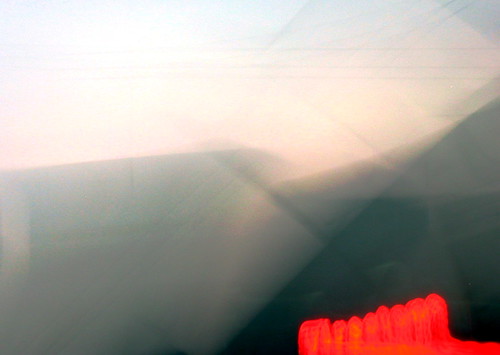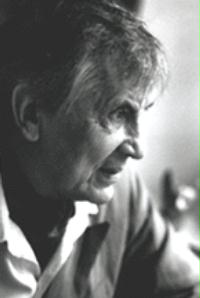
Opus 47
Photographer about painter. Robert Frank, living nearby, and able to see into de Kooning’s Tenth Street studio, writing of the painter: “I’d see him with his hands behind his back, his head bent, pacing up and down the length of his studio. I could see the easel standing there and I’d wonder if he ever would get to paint and stop walking up and down. Quite often I think of that image now. That was the time when I was a photographer, doing jobs or going out on my own to photograph in the streets. Then it seemed to me I was making a big effort. Now thinking of de Kooning, I understand better what it is, to face a white sheet of canvas; to face something which does not respond to my movements, all will have to come from inside me. No help looking through the viewfinder and choosing the Decisive Moment . . .” See de Kooning’s practice of putting letters to paintings—particularly in the black paintings of the early ’fifties—something to begin with. See the practice of “blind” drawing—figures limned without looking. Overcoming inertial tendency. See writers “beginning with a line by . . .” “After Baudelaire.” “After anybody else so long’s it need not ‘come from inside me.’” Translating, of course, puts something in the viewfinder. So does reading.
—
Painter about writers. De Kooning: “I don’t think writers are necessarily more intelligent or better speakers than artists, but I find their conversation very stimulating. Sometimes I could say of my self that I painted with a good ear, because their talk, the words the used, made a picture in my mind.” What’s that remark’s relationship to Frank O’Hara’s short ditty titled “Radio”? It begins:
Why do you play such dreary musicLongs for Prokofiev, and ends:
on Saturday afternoon, when tired
mortally tired I long for a little
reminder of immortal energy?
. . .
Well, I have my beautiful de KooningWhat, too, is the relationship between “more than the ear can hold” and Charles Olson’s syncopated dictum (in “I, Maximus of Gloucester, to You”) instructing how as “facts to be dealt with . . . / . . . they must / be played by, said he, coldly, the / ear!” George Butterick, in the Guide to The Maximus Poems says of the piece: “Probably written in May 1950 in Washington, as a letter to Vincent Ferrini in Gloucester . . . The original version beginning “By ear, he sd,” appeared in the first collection of the poems, The Maximus Poems / 1-10, published by [Jonathan] Williams in October 1953.” Also published in the first issue of Origin in the spring of 1951. Likely enough that O’Hara-the-attender would’ve seen it.
to aspire to. I think it has an orange
bed in it, more than the ear can hold.
—
One finds out in the notes to O’Hara’s Collected Poems that “Radio” is dated December 3, 1955. And that Kenneth Koch wrote in a letter to O’Hara (March 22, 1956), presumably after reading it in the March issue of Poetry: “RADIO is perfect. I was in the Cedar Tavern last night and Bill de Kooning was there, so I asked him if he’d seen your poem about his picture. He said, Yeah, is that right? He said, Yeah, but how can you be sure it’s about my picture, is it just about a picture? I quoted him ‘I have my beautiful de Kooning / to aspire to. I think it has an orange / bed in it . . .’ He said, ‘It’s a couch. But then it really is my picture, that’s wonderful.’ Then he told me how he had always been interested in mattresses because they were pulled together at certain points and puffed out at others, ‘like the earth.’”
—
The de Kooning remark about painting “with a good ear” is traced back to a publish’d interview with one Storm de Hirsch of October 1955 (Intro Bulletin) making it likely that it’s O’Hara latching to de Kooning’s lingo? O’Hara—for all the unabash’d sonic fervor of’s verse—unwilling to diminish the clout of the visual. De Kooning—in the conversation with Koch, opting for the near tactile, “pulled together,” “puffed out.” (See, too de Kooning’s move in the early ’seventies into wet-clay sculpting.)
—
Philosopher crank about artists? E. M. Cioran: “Every project is a camouflaged form of slavery.”
—
Yesterday afternoon the opportunity to peer down out of the heights of the mezzanine at the diminutive violinist Midori, with Robert McDonald (piano) accompanying. Beethoven’s “Spring” sonata, the commission’d by Midori “Lost Landscapes for Violin and Piano” by the Finnish composer Einojuhani Rautavaara (b. 1928), the “unfinished” Hindemith “Sonata for Violin and Piano in E-flat Major,” and the sleep-inducing Strauss “Sonata for Violin and Piano in E-flat Major.” Two encores: Glazunov’s “Meditation” and Fritz Kreisler’s “Syncopation.” If the untrain’d ear had to select one highlight? The final movement of the Rautavaara, titled “West 23rd Street, NY”—high lilt of violin over a fast rolling quasi-atonal’d perpetuum mobile undercarriage of piano. A perfect invisible city.

